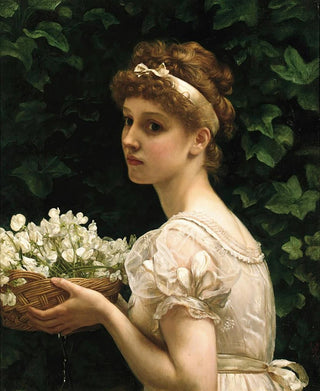Art print | Polka Dot Flowers - Edward John Poynter


View from behind

Frame (optional)
In the world of art, some artworks manage to transcend time and capture the very essence of beauty. "Pea Flowers - Edward John Poynter" is one of those creations that invites the viewer to immerse themselves in a floral universe filled with delicacy and poetry. This painting, which evokes the lightness of pea flowers, goes beyond a simple representation of nature. It encourages introspective contemplation, where each petal seems to whisper hidden secrets. The artist, through his brushstrokes, succeeds in creating an atmosphere that is both serene and vibrant, allowing the observer to feel a deep connection with nature.
Style and uniqueness of the work
Edward John Poynter's style is characterized by remarkable finesse and meticulous attention to detail. In "Pea Flowers," this uniqueness is expressed through soft colors and delicate shades that bring each element of the composition to life. The way the flowers are arranged suggests a gentle, almost airy dance, where light plays a crucial role. Poynter does not merely illustrate flowers; he animates them, giving them a personality of their own. Shadows and highlights blend harmoniously, creating a depth that draws the eye and holds it. This piece is a true ode to nature, where every brushstroke seems to celebrate the fleeting beauty of flowers.
The artist and his influence
Edward John Poynter, an emblematic figure of the Pre-Raphaelite movement, knew how to leave his mark on his era with his unique approach to art. Influenced by the great masters of the Renaissance, he also managed to incorporate modern elements into his work. His ability to fuse tradition and innovation made him a respected and admired artist. Poynter was also committed to teaching and promoting the arts, leaving a legacy that endures beyond his own production. His influence is felt across generations of artists who followed, inspired by his sense of aesthetics and technical mastery. "Pea Flowers" reflects this quest for beauty and truth, a testament to his creative genius.

Matte finish

View from behind

Frame (optional)
In the world of art, some artworks manage to transcend time and capture the very essence of beauty. "Pea Flowers - Edward John Poynter" is one of those creations that invites the viewer to immerse themselves in a floral universe filled with delicacy and poetry. This painting, which evokes the lightness of pea flowers, goes beyond a simple representation of nature. It encourages introspective contemplation, where each petal seems to whisper hidden secrets. The artist, through his brushstrokes, succeeds in creating an atmosphere that is both serene and vibrant, allowing the observer to feel a deep connection with nature.
Style and uniqueness of the work
Edward John Poynter's style is characterized by remarkable finesse and meticulous attention to detail. In "Pea Flowers," this uniqueness is expressed through soft colors and delicate shades that bring each element of the composition to life. The way the flowers are arranged suggests a gentle, almost airy dance, where light plays a crucial role. Poynter does not merely illustrate flowers; he animates them, giving them a personality of their own. Shadows and highlights blend harmoniously, creating a depth that draws the eye and holds it. This piece is a true ode to nature, where every brushstroke seems to celebrate the fleeting beauty of flowers.
The artist and his influence
Edward John Poynter, an emblematic figure of the Pre-Raphaelite movement, knew how to leave his mark on his era with his unique approach to art. Influenced by the great masters of the Renaissance, he also managed to incorporate modern elements into his work. His ability to fuse tradition and innovation made him a respected and admired artist. Poynter was also committed to teaching and promoting the arts, leaving a legacy that endures beyond his own production. His influence is felt across generations of artists who followed, inspired by his sense of aesthetics and technical mastery. "Pea Flowers" reflects this quest for beauty and truth, a testament to his creative genius.






